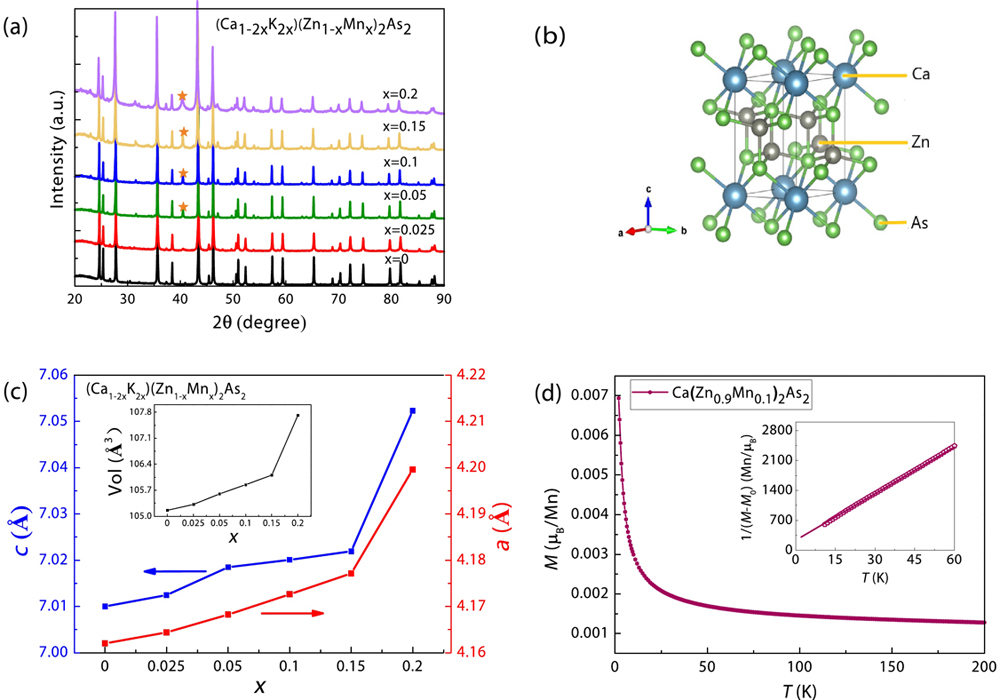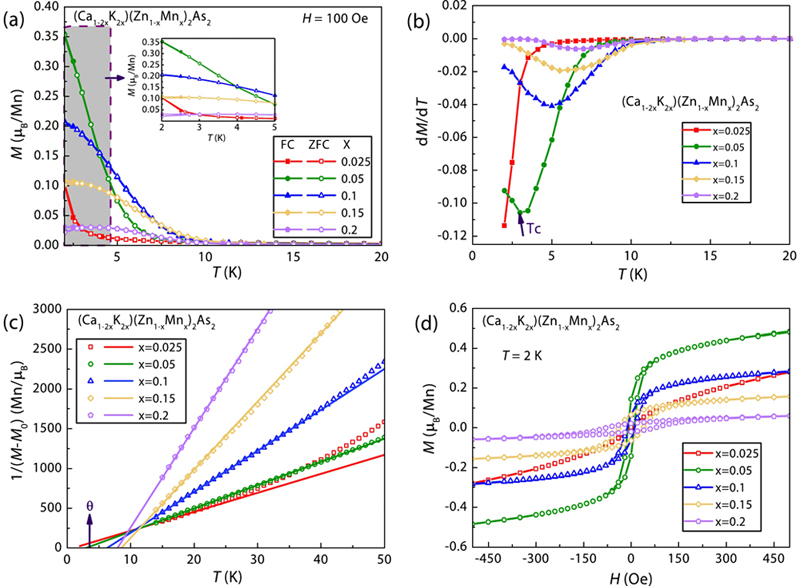Jinou Dong, Xueqin Zhao, Licheng Fu, Yilun Gu, Rufei Zhang, Qiaolin Yang, Lingfeng Xie, Fanlong Ning. (Ca,K)(Zn,Mn)2As2: Ferromagnetic semiconductor induced by decoupled charge and spin doping in CaZn2As2[J]. Journal of Semiconductors, 2022, 43(7): 072501
Search by keywords or author
- Journal of Semiconductors
- Vol. 43, Issue 7, 072501 (2022)

Fig. 1. (Color online) (a) The X-ray diffraction patterns for (Ca1−2xK2x)(Zn1−xMnx)2As2 (x = 0, 0.025, 0.05, 0.1, 0.15, 0.2). Star marks the impurities of KZn4As3. (b) The crystal structure of CaZn2As2. (c) The lattice parameters a and c of (Ca1−2xK2x)(Zn1−xMnx)2As2 (x = 0, 0.025, 0.05, 0.1, 0.15, 0.2). Inset is the volume of (Ca1−2xK2x)(Zn1−xMnx)2As2 (x = 0, 0.025, 0.05, 0.1, 0.15, 0.2). (The standard data are used for x = 0.) (d) The relation of temperature dependent magnetization of Ca(Zn0.9Mn0.1)2As2 measured in the field cooling under 100 Oe. Inset is the plot of 1/(M − M0) versus temperature. The data are marked by hollow dots and the fitting result is plotted by a straight line.

Fig. 2. (Color online) (a) The dependence between temperature and DC magnetization for (Ca1−2xK2x)(Zn1−xMnx)2As2 (x = 0.025, 0.05, 0.1, 0.15, 0.2) measured in zero field cooling (ZFC) and field cooling (FC) condition under 100 Oe external field. (b) The first derivative of magnetization versus temperature for (Ca1−2xK2x)(Zn1−xMnx)2As2 (x = 0.025, 0.05, 0.1, 0.15, 0.2). The arrow marks the Curie temperature (TC) of x = 0.05. (c) The reverse of M − M0 versus temperature for (Ca1−2xK2x)(Zn1−xMnx)2As2 (x = 0.025, 0.05, 0.1, 0.15, 0.2). The straight lines are the fitting lines and the hollow symbols are the data dots. The arrow marks the Weiss temperature (θ) of x = 0.05. (d) The iso-thermal magnetic hysteresis measurement for (Ca1−2xK2x)(Zn1−xMnx)2As2 (x = 0.025, 0.05, 0.1, 0.15, 0.2) under 2 K.
Fig. 3. (Color online) (a) The dependence between temperature and DC magnetization for (Ca1−2yK2y)(Zn0.95Mn0.05)2As2 (y = 0.05, 0.1, 0.15, 0.2) measured in zero field cooling (ZFC) and field cooling (FC) condition under 100 Oe external field. (b) The first derivative of magnetization versus temperature for (Ca1−2yK2y)(Zn0.95Mn0.05)2As2 (y = 0.05, 0.1, 0.15, 0.2). The arrow marks the Curie temperature (TC) of y = 0.15. (c) The reverse of M − M0 versus temperature for (Ca1−2yK2y)(Zn0.95Mn0.05)2As2 (y = 0.05, 0.1, 0.15, 0.2). The straight lines are the fitting lines and the hollow symbols are the data dots. The arrow marks the Weiss temperature (θ) of y = 0.15. (d) The iso-thermal magnetic hysteresis measurement for (Ca1−2yK2y)(Zn0.95Mn0.05)2As2 (y = 0.05, 0.1, 0.15, 0.2) under 2 K.
Fig. 4. (Color online) (a) Resistivity for CaZn2As2, Ca(Zn0.9Mn0.1)2As2 and (Ca0.8K0.2)Zn2As2 in log scale. (b) Resistivity for (Ca1−2xK2x)(Zn1−xMnx)2As2 for x = 0.025, 0.05, 0.1, 0.15, 0.2 in log scale.
|
Table 0. The Curie temperature TC, the Weiss temperature θ, the effective moment Meff , the saturation moment Msat and the coercive field Hc for (Ca1−2yK2y)(Zn0.95Mn0.05)2As2.
|
Table 0. The Curie temperature TC, the Weiss temperature θ, the effective moment Meff , the saturation moment Msat and the coercive field Hc for (Ca1−2xK2x)(Zn1−xMnx)2As2.

Set citation alerts for the article
Please enter your email address



